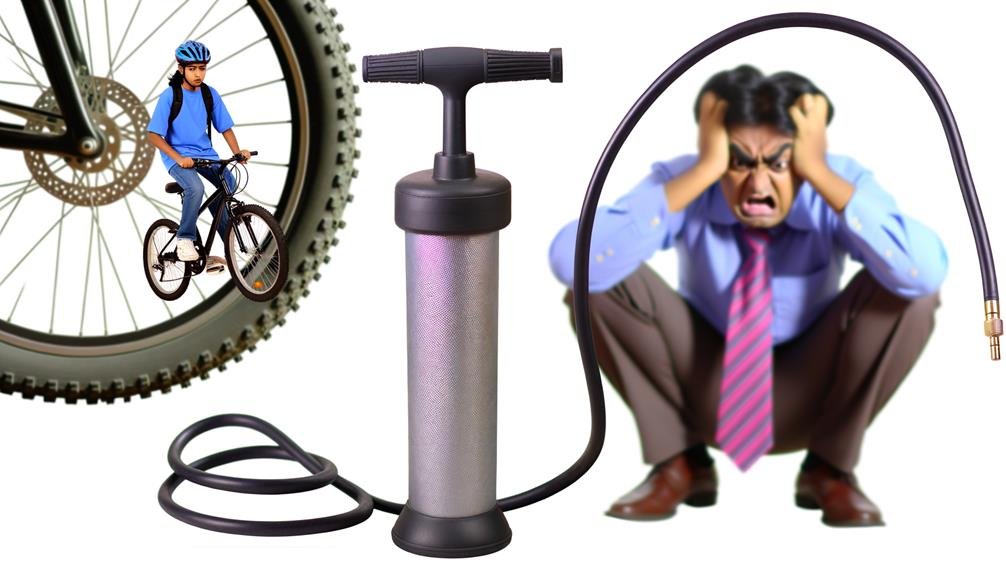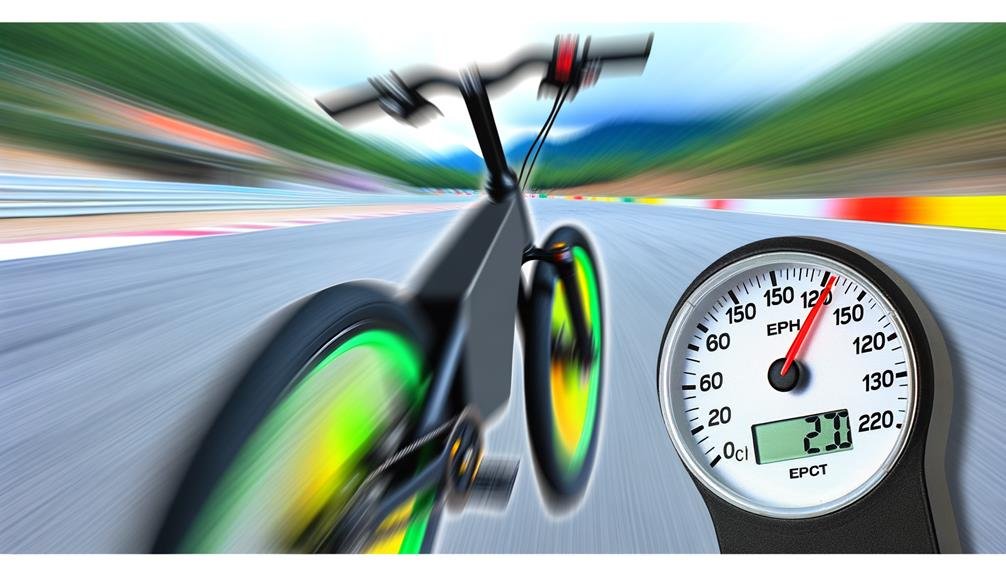Charles Miller is a veteran bike enthusiast with over 12 years of experience dealing with bikes as a mechanic. Despite immense love and expertise for...
You've heard about them, you've seen them in stores, and maybe you've even considered buying one. Electric bike pumps are touted as fast, accurate, and easy to use, but are they really worth the investment?
Just like any piece of gear, they come with their own set of benefits and drawbacks that can significantly influence your biking experience. So, let's start unraveling the mystery surrounding these high-tech devices – are they a game-changer or just another gadget gathering dust in your garage?
Key Takeaways
- Electric bike pumps offer effortless inflation and precise monitoring with a digital pressure gauge.
- They are beneficial for those with limited physical strength or mobility, providing quick and efficient inflation.
- Electric bike pumps may have a higher price tag compared to manual pumps, but the convenience and efficiency they offer can be worth the investment.
- Power source limitations can hinder the use of electric bike pumps in remote areas without electricity, and transporting them can be challenging due to their size and weight.
Understanding Electric Bike Pumps
Diving into the realm of electric bike pumps, you'll find a wealth of options, from compact devices like the Fumpa and miniFumpa, with their quick inflation and digital gauges, to the reliable, cordless pumps from brands like Makita, each with its own set of advantages and considerations.
As you delve deeper into understanding electric bike pumps, you'll realize they're more than just high-pressure devices; they're tools that enhance your biking experience.
The Fumpa and miniFumpa are perfect for you if you're constantly on the go. They're lightweight, quick, and offer the convenience of a digital gauge. However, the miniFumpa might fall short if you're a professional seeking accuracy as it lacks a pressure gauge. On the other hand, the Fumpa is a game-changer, providing accurate tire pressure faster and more conveniently than a floor pump.
If you're seeking reliability, cordless pumps like Makita are your best bet, with their long-lasting performance. Electric bike pumps may seem pricier, but they offer effortless inflation and precise monitoring. So, are electric bike pumps good? Well, it all boils down to your specific needs. For some, the benefits outweigh the cost, making it a worthy investment.
Benefits of Electric Bike Pumps
Undeniably, electric bike pumps offer a plethora of benefits that significantly enhance your biking experience, with effortless inflation at the top of the list. With just a push of a button, you're able to inflate your tires faster and more conveniently than ever.
Let's delve into the benefits of electric bike pumps. The digital pressure gauge provides accurate monitoring and inflation control. It isn't just a tool, it's your trusted companion for precision. For those with limited physical strength or mobility, these pumps are a godsend. You no longer need to wrestle with manual pumps; the electric version does the hard work for you.
In emergency situations, electric bike pumps shine. They offer quick and efficient inflation, helping you get back on the road in no time. And let's not forget the convenience they bring to your regular rides. Topping off your tire pressure before each ride ensures optimal performance, and these pumps make that task a breeze.
Lastly, modern electric bike pumps come with battery protection features, adding to their appeal. They're designed to be your reliable companions, helping you feel a sense of belonging in the biking community.
Drawbacks of Electric Bike Pumps

While you might appreciate the convenience of electric bike pumps, you should also consider the drawbacks.
Your wallet might take a hit, as these pumps often come with a higher price tag than their manual counterparts.
Additionally, they require a power source for recharging, potentially adding to your maintenance chores.
Issues with noise, limited use for tubeless tires, and the absence of an auto-off function can also pose challenges.
High Cost Issues
Despite the numerous benefits of electric bike pumps, you may find the relatively high price tag a significant drawback, especially when compared to their manual counterparts. High cost issues often arise with the advanced technology these pumps offer.
As a community that values cost-effectiveness, you might find it hard to justify the expense. We've taken your complaints to heart and provided affiliate links to reliable sellers offering discounted rates. But even at a reduced price, the cost may still be daunting for some.
This doesn't mean you should discard the idea of owning electric bike pumps. Remember, sometimes it's worth paying a bit more for convenience and efficiency. Weigh the pros and cons, and decide what suits your biking lifestyle best.
Power Source Problems
In light of their technological advancement, electric bike pumps present certain power source problems that can limit their convenience and portability.
As you may have experienced, electric pumps require a power source, which often means you're tethered to a wall outlet or a battery. This reliance can hinder your freedom, especially if you're venturing off into remote areas without electricity.
Moreover, if the battery dies and there's no life indicator, you're left stranded.
Even transporting these pumps can be a hassle due to their larger size and weight compared to manual pumps.
While electric pumps offer technological advantages, these power source problems can cause significant inconveniences, making them less ideal for certain situations.
Durability and Portability
You might appreciate the compact size of the miniFumpa, an electric bike pump that can fit into your saddlebag or jersey pocket, but you'll soon notice its blocky shape and rigid structure could pose a risk if you were to land on it in an accident.
Unlike other pumps with a Schrader Valve, it doesn't come with an on-bike bracket. Its lack of weatherproofing further questions its durability, affecting its portability as it might cease to work when exposed to moisture.
The pump heats up significantly during use. Plus, the battery requires frequent recharging, which could be a hassle during long trips.
Despite their convenience, electric bike pumps like the miniFumpa mightn't provide the reliability and practicality you're seeking.
Comparison: Electric Vs Manual Pumps

When it comes to choosing between electric and manual bike pumps, it's important to weigh the pros and cons based on your unique cycling needs and circumstances.
Electric pumps, such as those for electric bikes, offer faster inflation times and come with digital pressure gauges for accurate monitoring. They are a convenient choice if you prioritize speed, efficiency, and have limited physical strength or mobility.
On the other hand, manual pumps are lightweight and compact. They are more affordable and suitable for hands-on riders and can be used in various locations. However, they may be challenging to use for multiple tire inflation and achieving precise pressure.
Here's a quick comparison: electric vs manual pumps:
| Electric Pumps | Manual Pumps | |
|---|---|---|
| Inflation | Faster | Slower |
| Accuracy | High | Lower |
| Convenience | High | Medium |
| Portability | Medium | High |
Key Features to Consider
When choosing an electric bike pump, it's crucial to consider its key features.
Pay attention to essential pump specifications such as the digital pressure gauge, maximum pressure, and the ease of inflation.
Don't overlook the pump's efficiency, portability, and the type of power source it uses.
Essential Pump Specifications
In considering essential pump specifications for electric bike pumps, it's crucial to examine features like a digital pressure gauge, compactness, maximum pressure capacity, ease of use, and inflation speed. These factors determine the functionality of your electric pumps and contribute significantly to your overall biking experience.
To create a vivid picture in your mind, consider these key features:
- A digital gauge offers precise pressure readings, helping you maintain optimal tire pressure.
- Compactness ensures the electric tire pump is portable, providing an on-the-go solution for unexpected deflations.
- Maximum pressure defines the pump's suitability for various tire types, ensuring your pump isn't limited to a specific bike.
Each specification plays a crucial role in the performance and convenience of your electric pump. Make sure to factor these in when choosing your ideal tire pump.
Evaluating Pump Efficiency
Evaluating the efficiency of your electric bike pump boils down to a few key features that can drastically impact your biking experience. When choosing the best air pump, it's crucial to consider its power source, weight, cost, speed, and accuracy.
Here's a quick breakdown for you:
| Feature | Importance |
|---|---|
| Power Source | Electric pumps need a power source, affecting portability. |
| Weight | Heavier pumps are less portable but often more robust. |
| Cost | Electric pumps are generally more expensive but offer more features. |
| Speed | Electric pumps can inflate a tire quicker than manual pumps. |
| Accuracy | Digital gauges in electric pumps provide precise pressure readings. |
Popular Electric Bike Pump Brands

Among the myriad of electric bike pump brands, Fumpa and miniFumpa stand out due to their compact size, digital pressure gauge, and suitability for travel purposes. Both brands have made their mark in the realm of electric pumps, offering a blend of functionality and convenience that's hard to match. Whether you're off on a mountain bike adventure or commuting to work, these pumps are a savvy choice.
The company suggests the Fumpa for its accurate pressure gauge and quick usability. Conversely, the miniFumpa is ideal for emergency inflation and can easily be stashed in a saddlebag or jersey pocket. However, be aware that it may get hot during use and lacks a pressure gauge.
Here's a snapshot of what these popular electric bike pump brands offer:
- Fumpa: Compact and quick, with an accurate digital pressure gauge
- miniFumpa: Portable and speedy for emergency inflation, but lacks a pressure gauge
- Both: Not suitable for tubeless tires and may generate noise while in use
Frequently Asked Questions
What Is the Disadvantage of Bicycle Pump?
While electric bike pumps offer quick inflation speed, you might struggle with durability and portability issues. They're bulky, require more manual effort, and aren't as durable as you'd expect, making them less practical for you.
What Are the Disadvantages of Ebikes?
Sure, e-bikes are a revolution, but they've got their downsides. Battery limitations can leave you stranded, they're hefty to lug around, charging them's a pain, and don't get me started on their astronomical cost!
Does It Matter What Bike Pump You Use?
Yes, the bike pump you use matters. It affects pump efficiency, inflation speed, pressure accuracy, and pump durability. You'll want a pump that's reliable, gives accurate readings, and inflates quickly to meet your biking needs.
Can You Use an Electric Pump for Bike Tires?
Yes, you can use an electric pump for bike tires. They offer pump efficiency and speed, but consider battery lifespan and portability concerns. Regular pump maintenance is essential for longevity and optimal performance.
Conclusion
Imagine effortlessly inflating your bike tires, with precision and speed at your fingertips. An electric bike pump offers this luxury. However, their size, cost, and need for power may be cumbersome for some.
Ultimately, your cycling lifestyle and needs should guide your decision. Are you a casual rider or a dedicated cyclist? Do you ride off-grid or in urban areas?
Ponder these questions as you weigh the pros and cons of electric bike pumps.

Charles Miller is a veteran bike enthusiast with over 12 years of experience dealing with bikes as a mechanic. Despite immense love and expertise for his Tacoma, he rides his Trek Ebike more. Anytime you meet him, you’ll either hear him talking about Bikes, or writing about all things bikes and cars on this blog.
More Posts


